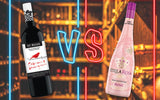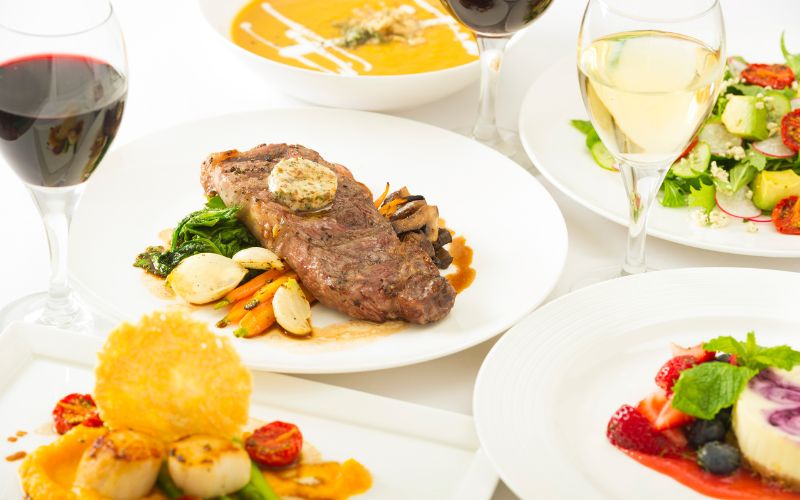
Dealcoholized Vs. Non-Alcoholic Wine: Which Is Better?


When passing by the alcohol section at a store, you may see wine bottles labeled as “dealcoholized” and “non-alcoholic.” Initially, you may be confused about the implication since wine is, in fact, an alcoholic beverage.
Both labels indicate that the drink is different from grape juice. Dealcoholized wines have had their alcohol content removed, while non-alcoholic wines underwent limited fermentation to control the production of alcohol.
The concept behind these two wines might be confusing. Luckily, we’ll shed some light on the dealcoholized wine vs. non-alcoholic wine matter so you can better understand them and determine which is closest to regular wine.
|
Category |
Dealcoholized Wines |
Non-Alcoholic Wines |
|
Ingredients |
Usual wine grapes (Cabernet Sauvignon, Chardonnay, etc.) |
Often unspecified wine grapes |
|
Process |
Vacuum distillation, reverse osmosis, and spinning cone technology |
Reduction of fermentable sugars, and interrupted fermentation |
|
Flavor Profile |
Complex, dry, wonderfully aromatic with a good texture |
Usually sweet and less tannic |
|
Food Pairings |
Savory, umami, light and, sweet dishes |
Spicy foods, and desserts |

Wine gets its alcohol by fermenting the sugars from grape juice. This usually results in 7%-24% ABV (alcohol by volume) in most wines. But when we say “dealcoholized,” it means the alcohol from a fully fermented wine has been removed either completely or partially.
Removing alcohol can be done using sophisticated methods that carefully extract the alcohol while leaving behind the polyphenols that give the wine its aromas and tastes.
In a few parts of the world, including the USA, South Africa, and the UK, dealcoholized wines are described to have less than 0.5% ABV. This amount renders it undetectable, and the human body can’t process it, keeping the drinker sober.

Most of the time, non-alcoholic wine is used as a synonym for dealcoholized wine because the former is also described as wines with less than 0.5% ABV. But, other non-alcoholic wines are derived through a reduction of alcohol content during fermentation rather than dealcoholization.
“Non-alcoholic” is quite ambiguous because drinks described as such are not entirely free from alcohol. That’s why it’s important to explicitly display the ABV on the bottle labels to prevent misleading buyers.
Most people argue that these drinks are not real wines since they didn’t go through the whole vinification process, unlike dealcoholized wines. To avoid confusion, some brands either omit the word “wine” after “non-alcoholic” or just call their products “wine alternatives.”
At this point, we’ll break down both wines into different categories to better explain how they’re similar and different from one another.

Red wines are made from dark grapes, while white wines are from green grapes. Other wines, like rosé, are made from a mix of red and white grapes. The concept is the same with dealcoholized wines.
Most leading brands of dealcoholized wines usually use grapes grown in California and in countries like Germany, Spain, South Africa, and New Zealand, to name a few.
On the other hand, non-alcoholic wines are not very explicit about the type of grapes they use. Their bottles are only referred to as red, white, sparkling, or juice.
Some non-alcoholic wines may have used lesser grapes that can’t compete with standard ones. Those labeled as “juice” may be made from Concord grapes.
However, since non-alcoholic wines are still fermented, albeit not fully, there is a chance that they are made from conventional wine grapes like Cabernet Sauvignon, Shiraz, Sauvignon Blanc, and more.
Good wine starts with good ingredients. And because dealcoholized wines are known to be created using the same wine grape types as regular wines, they win this round.

Dealcoholized wines start the same way as traditional wines. Grapes are harvested, crushed, and pressed, resulting in a juice that will be fermented.
After fermentation, the wine undergoes either of the three most well-known alcohol-removing processes: vacuum distillation, reverse osmosis, and spinning cone technology.
The first one uses a vacuum where wine is boiled at controlled, low temperatures to extract the alcohol from the wine. The second method involves pumping the wine and filtering it multiple times to separate the alcohol from the flavor and aroma compounds. The third process uses centrifugal force to allow the alcohol to evaporate, thus separating it from the rest of the wine.
Non-alcoholic wines don’t go through the whole fermentation. Instead, fermentable sugars are reduced before fermentation, or alcohol production is reduced during fermentation.
When reducing fermentable sugars, the juice can be diluted with water or filtered to separate some of the sugars from the juice. Another method is to use glucose oxidase, which causes fermentable sugars to oxidize and lowers the ethanol to be produced.
Moreover, reducing alcohol during fermentation can be done using three methods. One is the intentional interruption of fermentation after the desired level of ethanol concentration is reached. This process involves lowering the fermentation temperature or adding sulfur dioxide to the wine to stop the fermentation.
Another method is to limit yeast biomass to create a low fermentation rate of sugars, which in turn creates low ethanol. The last method is to use modified yeast strains with low capabilities to create ethanol.
For this category, dealcoholized wine takes the cake because although the alcohol-removing process uses costly and advanced technology, it does better at retaining the polyphenols, resulting in better-tasting wines.

The alcohol-removing process of dealcoholized wines is generally executed gently to retain as much of the polyphenols that give wines their complex tastes and aromas.
And because they are fermented, there are very little to no residual sugars, giving way to more complex flavors rather than just being sweet.
In contrast, non-alcoholic wines tend to be on the sweeter side since they are not fully fermented. Some people may even perceive them as just grape juice because of the lack of bite, aromas, and deep flavors that wine has.
The taste of dealcoholized and non-alcoholic wines mostly depends on how they’re made. While dealcoholization methods are imperfect in retaining all flavor compounds, they are still better than those used to make non-alcoholic wines.
At times, non-alcoholic wines will end up being too diluted or flat. That’s why some winemakers add flavorings from fruit, spices, tea, and more to replicate wines' flavor profiles. Unfortunately, some bottles still miss the mark.
Dealcoholized wines have the advantage of fermentation, transforming ordinary grape flavors into something deeper and more nuanced. This is why they taste more closely to their alcoholic counterparts, making them more enjoyable to sip.

Both dealcoholized and non-alcoholic wines must have less than 0.5% alcohol by volume. If the alcohol content is below 0.05%, they are called alcohol-free. And anything that goes beyond 0.5% is called a low-alcohol wine.
No matter the process used, winemakers must strive to achieve the threshold to properly label their products and inform consumers of the small presence of alcohol.
Despite having a tiny bit of alcohol in each bottle, dealcoholized and non-alcoholic wines won’t give hangovers to people. The lack of alcohol makes them a great alternative for people who can’t drink alcoholic beverages due to dietary restrictions, religious beliefs, or conditions.

Product labeling is important to convey the correct information to customers. Wines labeled as “dealcoholized” or “alcohol-removed” denote that they were fermented and had their alcohol removed.
And to further provide clarity to customers, the Food and Drug Administration (FDA) requires that the label also display a disclaimer that the wine contains less than 0.5% ABV.
Moreover, the FDA considers drinks, whether wine, juice, or soda, with less than 0.5% ABV as “non-alcoholic.” This is why the FDA doesn’t object to using the terms “non-alcoholic” together with “dealcoholized” on wine labels.
Some people who don’t know about this alcohol threshold may presume that non-alcoholic wines have absolutely zero alcohol, where in fact, they don’t. With this, the FDA does not approve of using “non-alcoholic” as the only modifier to describe wines that are actually dealcoholized to avoid misleading buyers.
Non-alcoholic wines made using methods other than dealcoholization also contain the word “non-alcoholic” on their labels. However, the term is succeeded with words like “sparkling beverage,” “juice,” or “drink” instead of “wine.”
If you think about it, foregoing the word “wine” makes sense since these drinks weren’t fully fermented. But why do some people refer to them as “non-alcoholic wine” despite not having this phrase displayed explicitly on the labels? We think it has something to do with the bottle design.
Given that they look more akin to traditional wine bottles than grape juice bottles, people may assume they are indeed wine. But confusion is lessened if buyers pay more attention to the label and read the full description.

Since dealcoholized wines still contain the classic bitter taste and pleasant aromas, it is easy to pair them with food traditionally served with regular wine.
Dealcoholized red wines still go well with dark meat dishes and stews, while white wines are perfect with seafood and poultry dishes. Sparkling versions, as well as rosé, will be good with desserts and side dishes.
In the case of non-alcoholic wines, one may need to adjust the food pairings to suit their flavor profile better.
Since most non-alcoholic wines are sweet, they would pair well with spicy dishes. You can also have salty foods like pizza or chips for the sweet-salty combo or some sour dishes to balance the drink’s sweetness. If you’re pairing with sweet food, try anything other than chocolate, such as caramel, vanilla, and coconut.

Dealcoholized wines are a great substitute for making wine-based mocktails, like mulled wine, sangria, and wine spritzer. They still contribute their complex flavors, great mouthfeel, and fruity tastes that complement other mixers and non-alcoholic spirits.
Dealcoholized sparkling wines are even better for mocktails since they add a refreshing aspect with their bubbles and light flavor.
Non-alcoholic wines can also be used as an ingredient for mocktails, but they might be better off as mixers rather than the base. Since they are quite sweet, you may need to adjust the recipe so the resulting drink won’t be overly sweet.
Other than sweetness, non-alcoholic wines don’t add much to drinks since they don’t have the same texture and complexity as dealcoholized wines.

Despite incurring additional costs in removing alcohol or modifying the fermentation process, most dealcoholized and non-alcoholic wines cost just as much as alcoholic wines, if not cheaper.
Cheap bottles can range from $5 to $15, while expensive wines can go up to $30. Some people may have opinions on whether the price is justified, especially since these drinks don’t have the same taste as regular wines.
But once they know about the advantages of dealcoholized and non-alcoholic wines, they may find the cost reasonable.
Dealcoholized wines and non-alcoholic wines are similar to each other in many aspects. The only major difference is how they’re made, which subsequently affects their tastes. It is also mainly the process that gives dealcoholized wines the edge.
Nevertheless, people are still bound to have their preferences and will enjoy drinking wine either way.
Have you tried dealcoholized or non-alcoholic wines? We’d love to hear about your experience in the comments below.

